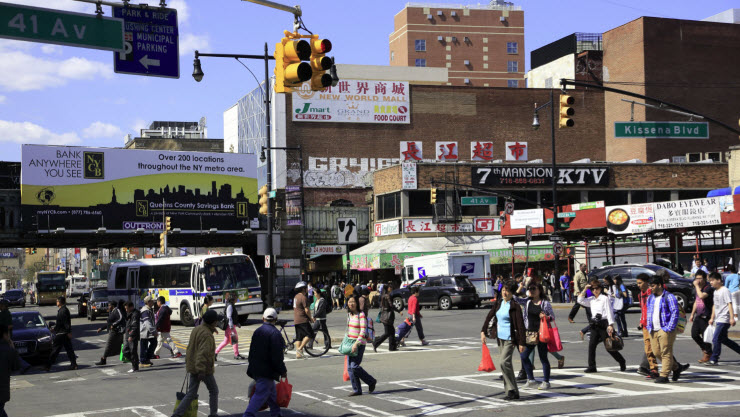
Flushing is a neighborhood in the north-central portion of the New York City borough of Queens. The neighborhood is the fourth-largest central business district in New York City. Downtown Flushing, a major commercial and retail area centered around the intersection of Main Street and Roosevelt Avenue, is the third-busiest intersection in New York City, behind Times and Herald Squares. Flushing is located in Queens Community District 7, and its ZIP Codes are 11354, 11355, and 11358. Flushing contains numerous residential subsections, and the numerous ethnic groups that reside in those communities reflect its vibrant diversity.
Minutes from midtown Manhattan, Downtown Flushing is the largest urban center in Queens and home to the second largest Chinatown in New York City. Get off the MTA #7 subway terminal or the Long Island Rail Road’s Port Washington branch at Flushing Main Street and step into a vibrant commercial district. It’s downtown sidewalks pulse with people of all nationalities but they are predominantly East Asians, specifically Chinese and Koreans. Signs in Chinese are at least as prominent as those you’ll find in English. This Chinatown, though, is a real American fusion.
The Flushing Chinatown houses over 30,000 individuals born in China alone, the largest Chinatown by this metric outside Asia and one of the largest and fastest-growing Chinatowns in the world. In January 2019, the New York Post named Flushing as New York City's "most dynamic outer-borough neighborhood." However, East Flushing also significantly includes Irish, Greek, Russian, Italian and Jewish communities, as well as communities of Indians, Sri Lankans, Malaysians, and Hispanics, mostly Colombians and Salvadorans.
The northeastern section of Flushing near Bayside continues to maintain large Italian and Greek presences that are reflected in its many Italian and Greek bakeries, grocery stores and restaurants. The northwest is a mix of Jews, Greeks, and Italians. Most of central Flushing is an ethnic mix of Whites, Hispanic Americans, and Asian Americans. The area south of Franklin Avenue houses a concentration of Indian, Pakistani, Afghan, and Bangladeshi markets. This concentration of Indian American and other South Asian American businesses south of Franklin Avenue has existed since the late 1970s, one of the oldest Little India in North America.
Because of this diversity, Flushing is among the most religiously diverse communities in America. There are more than 200 houses of worship in Flushing. "Flushing has become a model for religious pluralism in America," says R. Scott Hanson, a visiting assistant professor of history at the State University of New York at Binghamton and an affiliate of the Pluralism Project at Harvard University.
Landmarks, Museums and Cultural Institutions
Flushing has many registered New York City Landmarks, several of which are also located on the National Register of Historic Places. Several city landmarks are located on the Queens Historical Society's Freedom Mile.
Flushing Town Hall on Northern Boulevard is the headquarters of the Flushing Council on Culture and the Arts, an affiliate of the Smithsonian Institution, and it also houses a concert hall and cultural center.
- Bowne House
- Kingsland Homestead
- Weeping Beech
- Old Quaker Meeting House,
- Flushing High School,
- St. George's Church
- Lewis H. Latimer House
- Interior of the former RKO Keith's movie theater.
- Flushing Armory, on Northern Boulevard, former site of the National Guard.
Flushing is also home to Flushing Meadows Corona Park, the largest park in Queens. The site has hosted two World's Fairs, in 1939–1940 and 1964–1965, and the park’s infrastructure reflects the architectural construction undertaken for the Fairs. The northern part of the park contains Citi Field, home of the New York Mets of Major League Baseball; which replaced the former Shea Stadium. To the south is the USTA Billie Jean King National Tennis Center which is the home of the US Tennis Open, Arthur Ashe stadium.
Several attractions were originally developed for the World's Fairs in Flushing Meadows-Corona Park. Notably, one of the most prominent is the Unisphere, the iconic 12-story-high stainless steel globe that served as the centerpiece for the 1964 New York World's Fair, which was made a city landmark. Additionally, there is a stone marker for the two 5,000-year Westinghouse Time Capsules made of special alloys buried in the park, chronicling 20th-century life in the United States, dedicated both in 1938 and 1965. Also in the park are the Queens Museum of Art, which features a scale model of the City of New York, the largest architectural model ever built; Queens Theatre in the Park; the New York Hall of Science; and the Queens Zoo. The New York State Pavilion was listed on the National Register of Historic Places in 2009.
